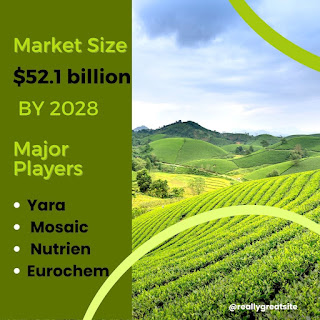 |
| Protected Cultivation Market Analysis |
The agricultural landscape is undergoing a metamorphosis. Forget the idyllic image of endless fields bathed in sunlight. Enter the world of protected cultivation, a revolutionary approach that's blossoming into a multi-billion dollar industry. Imagine climate-controlled havens where crops flourish under meticulously monitored conditions, unaffected by unpredictable weather or seasonal limitations. This isn't science fiction; it's the future of food production.
Stats that speaks the Market Growth
The global protected cultivation market is projected to be a $52.1 billion behemoth by 2028, experiencing a growth spurt exceeding a staggering 7.8% annually (Research says). This isn't just a passing trend; it's a response to a growing need for:
Food Security Fortress: With a projected global population of 9.7 billion by 2050 (United Nations, 2023), reliable food sources are critical. Protected cultivation offers year-round production, mitigating the impact of unpredictable weather patterns and a changing climate.
Sustainability Champion: This approach champions responsible resource use. Controlled environments allow for up to 70% less water usage compared to traditional agriculture (FAO, 2020), reduced reliance on pesticides, and precise fertilizer application, aligning perfectly with sustainable agriculture practices.
Yield & Quality Powerhouse: Imagine thriving crops immune to harsh weather and pests. Protected cultivation allows farmers to optimise growing conditions, resulting in increased yields by up to 30% (International Society for Horticultural Science, 2021) and superior quality produce.
A Diverse Ecosystem of Innovation
The protected cultivation market isn't a one-size-fits-all solution. It boasts a rich ecosystem of offerings catering to specific agricultural needs, with a projected market segmentation of:
Greenhouse Gurus (40% Market Share): This segment focuses on the infrastructure itself, with cutting-edge greenhouses, high tunnels, and vertical farms utilising advanced materials and climate control systems. Major players like Prins Group (Netherlands) and Lumigrow (Israel) are leading the charge here.
Crop Protectors (30% Market Share): They're the invisible guardians. This segment provides specialised fertilizers, biopesticides, and other solutions tailored for controlled environments, ensuring optimal crop health. Big names like Bayer (Germany) and Syngenta (Switzerland) dominate this space.
Tech Tillers (30% Market Share): Data is the new fertilizer! This segment offers automation and monitoring systems – sensors, irrigation tools, and automated climate control solutions – to optimise growth and resource management. John Deere (USA) and Priva (Netherlands) are key players here.
Meet the Market Movers & Shakers with Investment Potential
Innovation thrives in the protected cultivation industry. Who are the key players making it all happen, creating a landscape ripe for investment?
Horticultural Heavyweights: Agribusiness giants like Dole Food Company (USA) and Driscoll's (USA) are embracing protected cultivation to ensure consistent quality and year-round production, investing heavily in this sector.
Tech Titans Emerge: Companies like Siemens (Germany) are developing advanced lighting systems, while Philips (Netherlands) is revolutionising climate control solutions. These advancements are attracting significant venture capital funding.
Seed Savvy Specialists: Seed companies like Syngenta (Switzerland) are creating new crop varieties specifically suited for controlled environments, ensuring optimal growth under artificial conditions. This targeted approach presents exciting investment opportunities.
Challenges in Protected Cultivation Market
While the future is bright, some hurdles need to be addressed to ensure sustainable growth:
Cost Considerations: Setting up protected cultivation facilities requires significant upfront investment, potentially deterring smaller farmers. Government grants and subsidies can play a crucial role in increasing accessibility.
Knowledge Gap: Small-scale farmers may lack access to the expertise and technology needed to operate these facilities effectively. Educational programs and training initiatives are essential to bridge this knowledge gap.
Regulatory Maze: Varying regulations and standards across regions can create confusion and hinder wider adoption. Standardisation efforts can pave the way for smoother global market integration.
 |
| Protected Cultivation Industry |
Strategies for a Sustainable Food Future
Here's how to cultivate a thriving protected cultivation market future and contribute to a more sustainable food system:
Cost-Effectiveness is King: Develop affordable solutions tailored for small and medium-scale farmers, making this technology accessible to a wider audience. This could involve modular greenhouse designs, prefabricated components, and innovative financing options.
Knowledge Blooms Through Education: Create educational programs and training initiatives delivered through online platforms, mobile apps, and in-person workshops. Partner with universities and agricultural institutions to develop standardised curriculums.
Policy Power: Advocate for government support and incentives, encouraging investment in protected cultivation technologies and infrastructure. This could include tax breaks for adopting these technologies and funding research and development initiatives.
Data Drives Decisions: Develop user-friendly platforms that analyse real-time data from sensors and weather stations within protected cultivation facilities. Provide farmers with actionable insights on optimising yield, resource management, and overall crop health.
The Future of Protected Cultivation Industry
Protected cultivation isn't just about maximising yields; it's about building a more resilient and sustainable food system for a growing population. By embracing innovation, fostering knowledge sharing, prioritising affordability, and advocating for supportive policies, businesses can be a part of this revolution. Let's cultivate a future where fresh, high-quality food is accessible to all, regardless of climate or season. The protected cultivation market is ripe for investment and innovation, offering a unique opportunity to be a part of the solution for a more sustainable future of agriculture.
Comments
Post a Comment